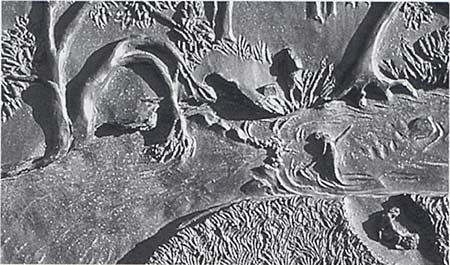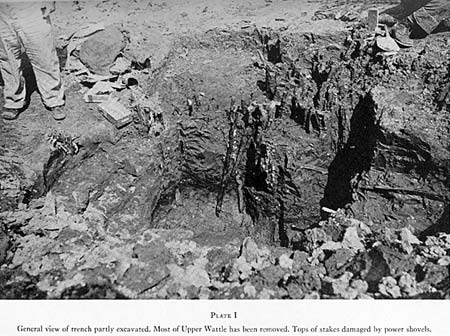Long before
European settlers named and shaped the Charles, Native Americans
living in New England made the river
a central part of their lives.
The Indian name for the Charles River was "Quinobequin,"
meaning meandering.
Anecdotal and archaeological evidence has left behind some
clues as to how American Indians lived alongside the river.
This detail from a bronze
relief at a park along the Charles River in Charlestown
shows a twentieth-century artist's imagination and memorialization
of Native American life along the Charles.

In the center of the image you can see a person standing
in the middle of the river in front of what looks like a small
dam. This is a fishweir, a complicated constructed trap designed
to catch fish.
The Boylston Street Fishweir
Boston is home to one of the oldest archaeological
finds in New England, the Boylston Street Fishweir. Boylston
Street, like the rest of Boston's Back Bay neighborhood, was
once part of the Charles River estuary -- the body of water
where the Charles River met Boston Harbor and the Atlantic
Ocean. An archaeological project, initiated in the early twentieth
century because of some construction projects, uncovered an
extremely old fishweir far below street level. Native Americans
had constructed this to trap fish several thousand years ago.
Archaeological explorations of the site have continued during
subsequent construction projects. The fishweir was located
near the site of Copley Square and the John Hancock tower.

Constructed of spokes of wood with brush and other objects
squeezed in to form wattling, the fishweir would trap everything
from oysters to alewifes.
The images below show aspects of how the fishweir worked,
and the remains that exist in downtown Boston, of what thousands
of years ago was a working maritime economic enterprise:
Other Archaeological Sites of pre-European Activity on
the Charles
Dena Dicuze, a Harvard archaeologist affiliated with the
Peabody Museum, conducted extensive research of Native American
sites along the Charles River, extending to the inland towns
far beyond Boston. You can view
pictures of some of these artifacts, or visit them at
Harvard's Peabody Museum. A map
she has prepared shows the location of these sites.
Web Links on Archaeology of the Charles River
Visit these sites on the world-wide-web to learn more about
the Boylston Street Fishweir, and archaeological projects
along the Charles River. Many of them have been funded by
archaeological projects required by the Big Dig, New England's
most recent effort to re-shape the Charles River.
|